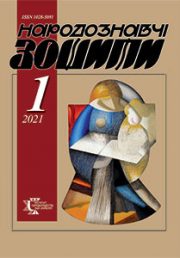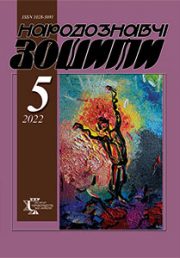The Ethnology Notebooks. 2017, 5 (137), 1156—1161
UDK 75.03 (477.8) “18”
DOI https://doi.org/10.15407/nz2017.05.1156
Bobosh Yaroslav Mykolaiovych, laboratory assistant
at the Department of Academic Drawing
at the Lviv National Academy of Arts,
Kubiiovycha Str., 38, Lviv, 79011, Ukraine.
Contacts: Tel. (032) 2761482; e-mail: office@lnam.edu.ua
Abstract. One aspect of the national idea in Western painting artist Julian Pankevych of the late XIX — early XX century is highlighted. The icon of Virgin Mary with Jesus, which is located in St. Elijah Borschiv villages in Lviv region is described. Found that village boy, the artist painted from the back, dressed in keptaryk with hands folded together, prays to the Virgin is young John the Baptist. The image of the Virgin Mary with Jesus recalls ancient iconographic type icons «admiration», which is distributed in the Western art of the Renaissance. Virgin Mary with Jesus often depicted with young John the Baptist.
Keywords: Galicia, Icon, Blessed Virgin Mary with Jesus, John the Baptist, Art.
Received 27.06.2017
REFERENCES
Bobosh, Ya. (1994). Sakral’na tematyka v tvorchosti Kornyla Ustyianovycha. Schovypadnyk mystetstva literatury, 12, 35—38 [in Ukrainian].
Vozniak, M. (1938). Z lystiv Kornyla Ustyianovycha do I. Franka. Novyj chas, 33 [in Ukrainian].
Hereta, I. (1994). Khudozhnyky Ternopil’schyny kintsia XIX — poch. XX st.: Yulian Pan’kevych (1863—1933). Ternopil’ [in Ukrainian].
Kasiian, V.I. (1970). Zhyvopys na Zakhidnykh zemliakh Ukrainy. Istoriia ukrains’koho mystetstva (Vol. 4 (2), pp. 195— 229). Kyiv : Zhovten’ [in Ukrainian].
Kachurak, K. (1900). Artystychna vystavka Tovarystva dlia rozvoiu rus’koi shtuky u L’vovi v 1900 rotsi. Dilo, 251 [in Ukrainian].
Nanovs’kyj, Ya. (1986). Yulian Pan’kevych: narysy pro zhyttia ta tvorchist’. Kyiv : Mystetstvo [in Ukrainian].
Noha, O. (1997). Proekt pam’iatnyka Ivanu Levyns’komu. L’viv : Ukrains’ki tekhnolohii [in Ukrainian].
Pan’kevych, Yu. (1898). O scho zh vlastyvo khodyt’… Dilo, 286, 2 [in Ukrainian].
Trush, I. (1899). Chy mozhlyva u nas shtuka. Buduchnist’, 7, 10—41 [in Ukrainian].
Klimaszewski, A. (1900). Szkolny przemysl domowy: przewodnik przemyslowy. Lwow.
O stanie szkolnicwa. (1894). Kurjer Lwowski, 188, 1 [in Polish].







